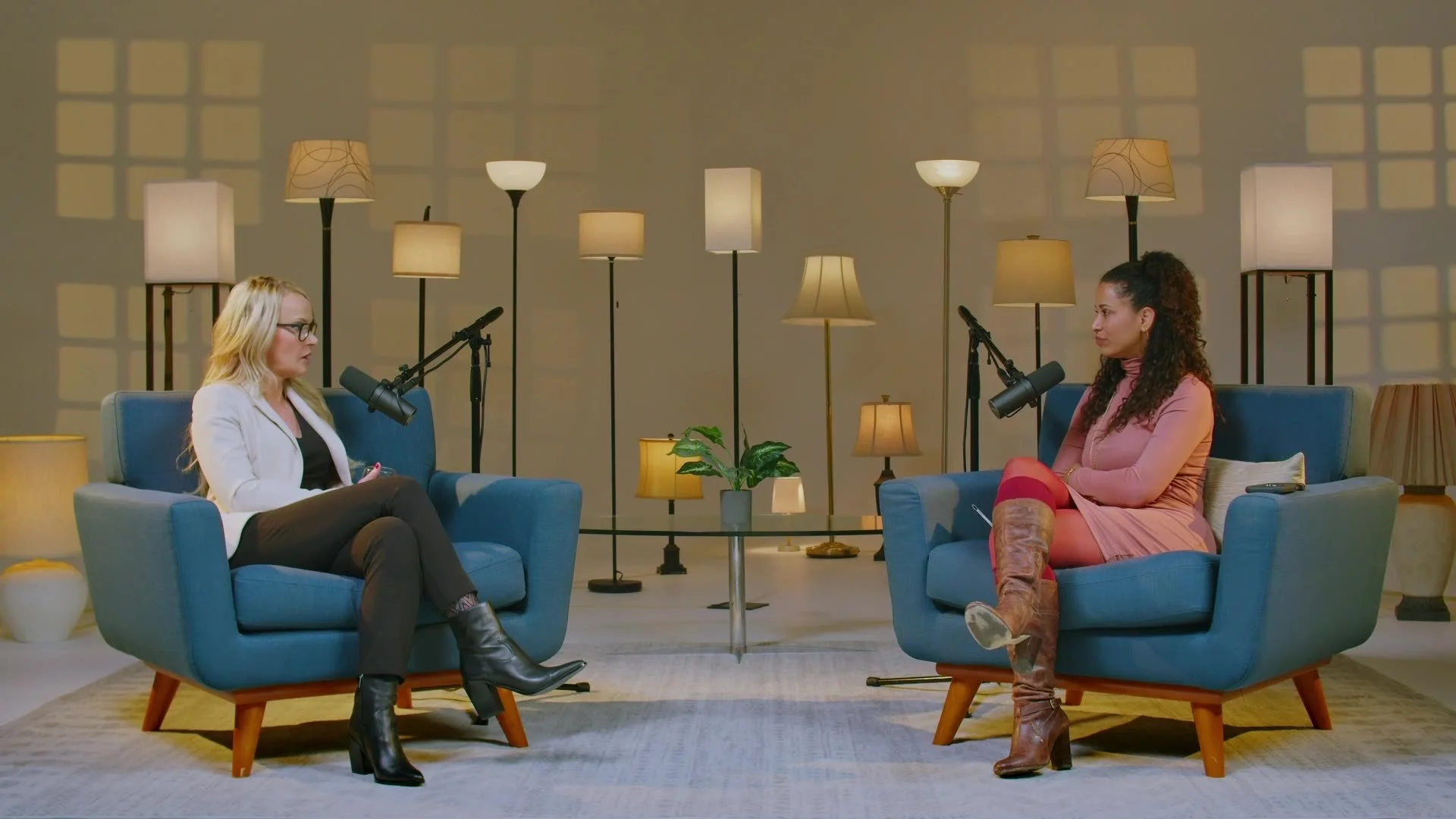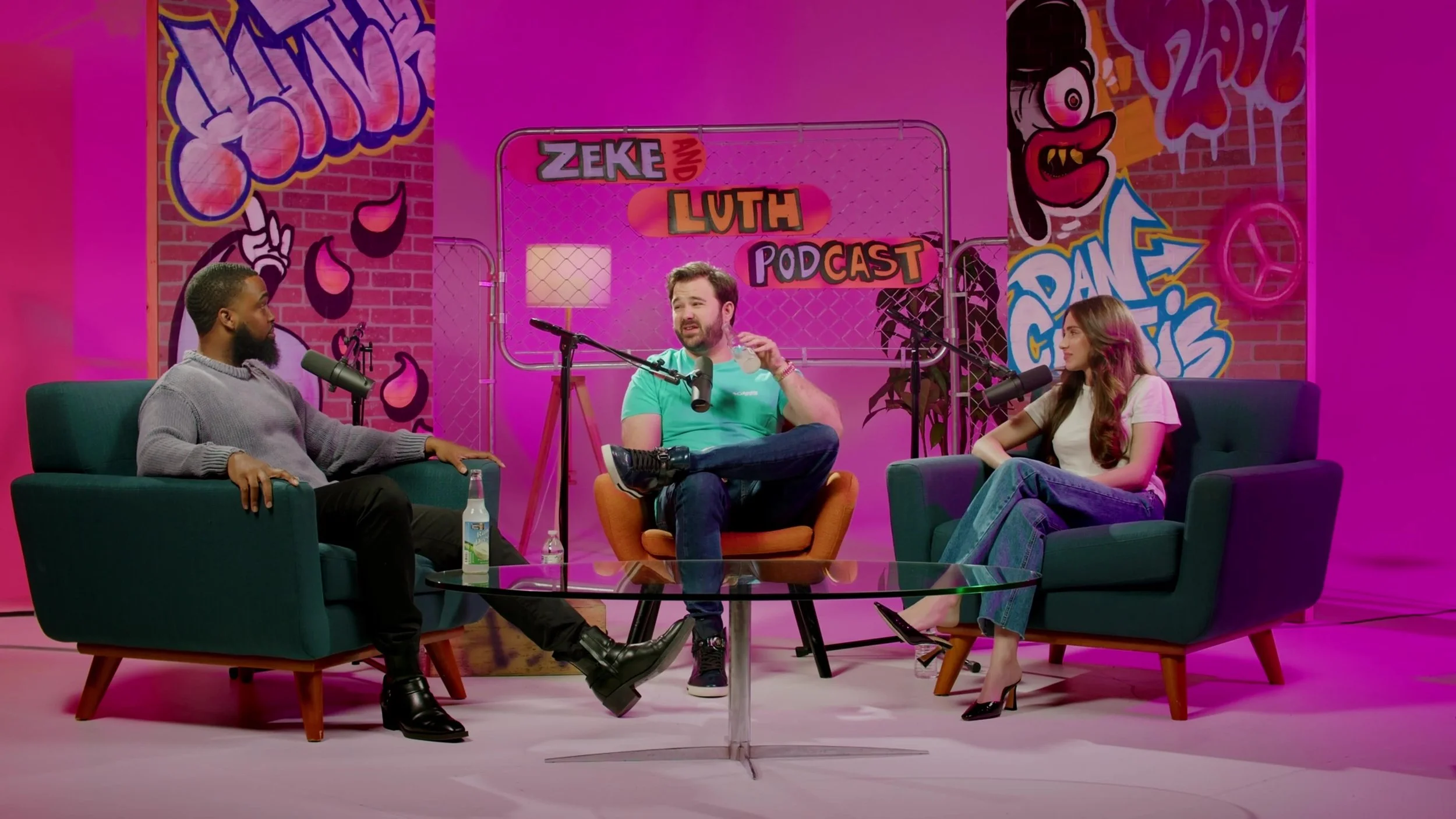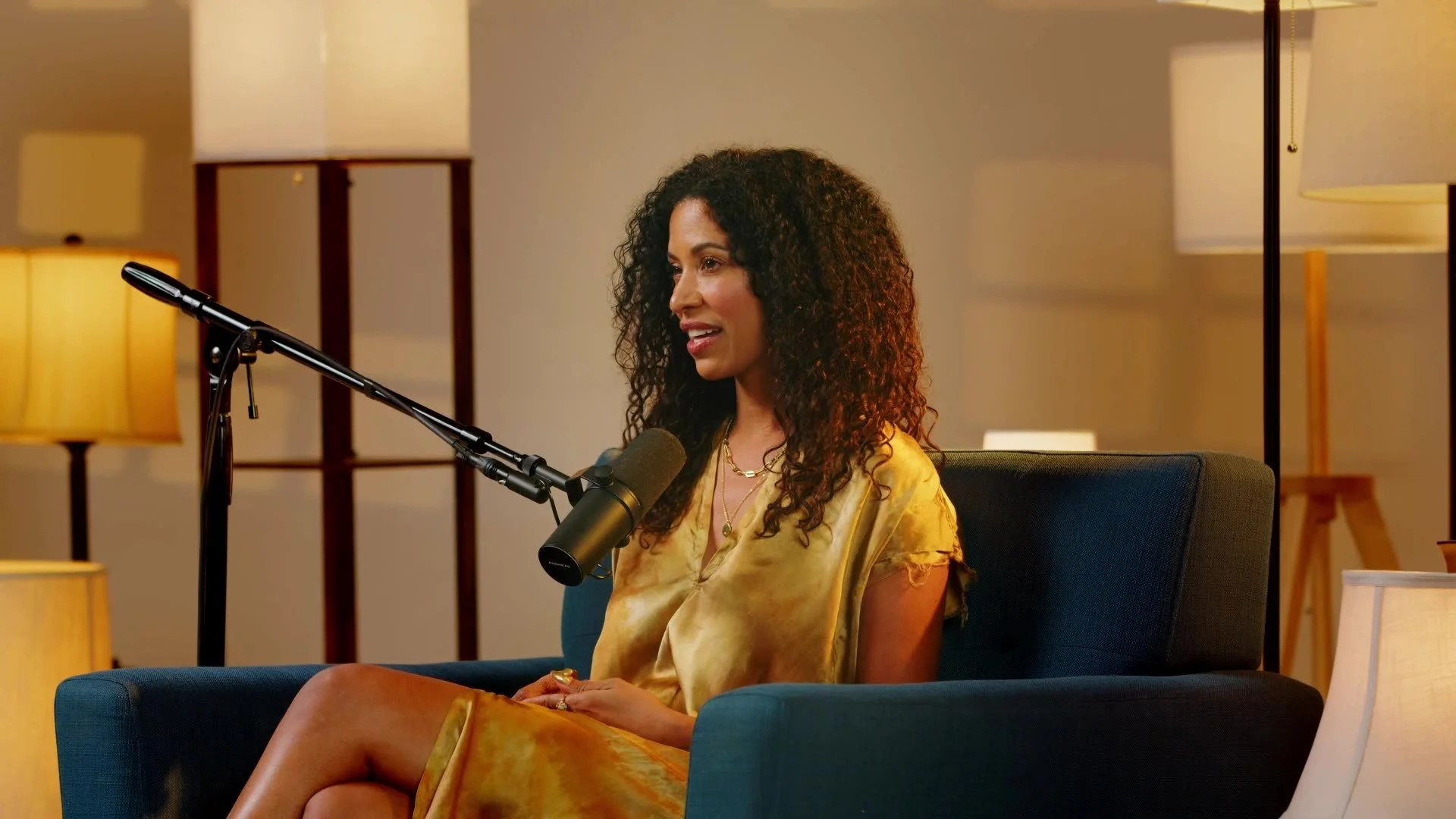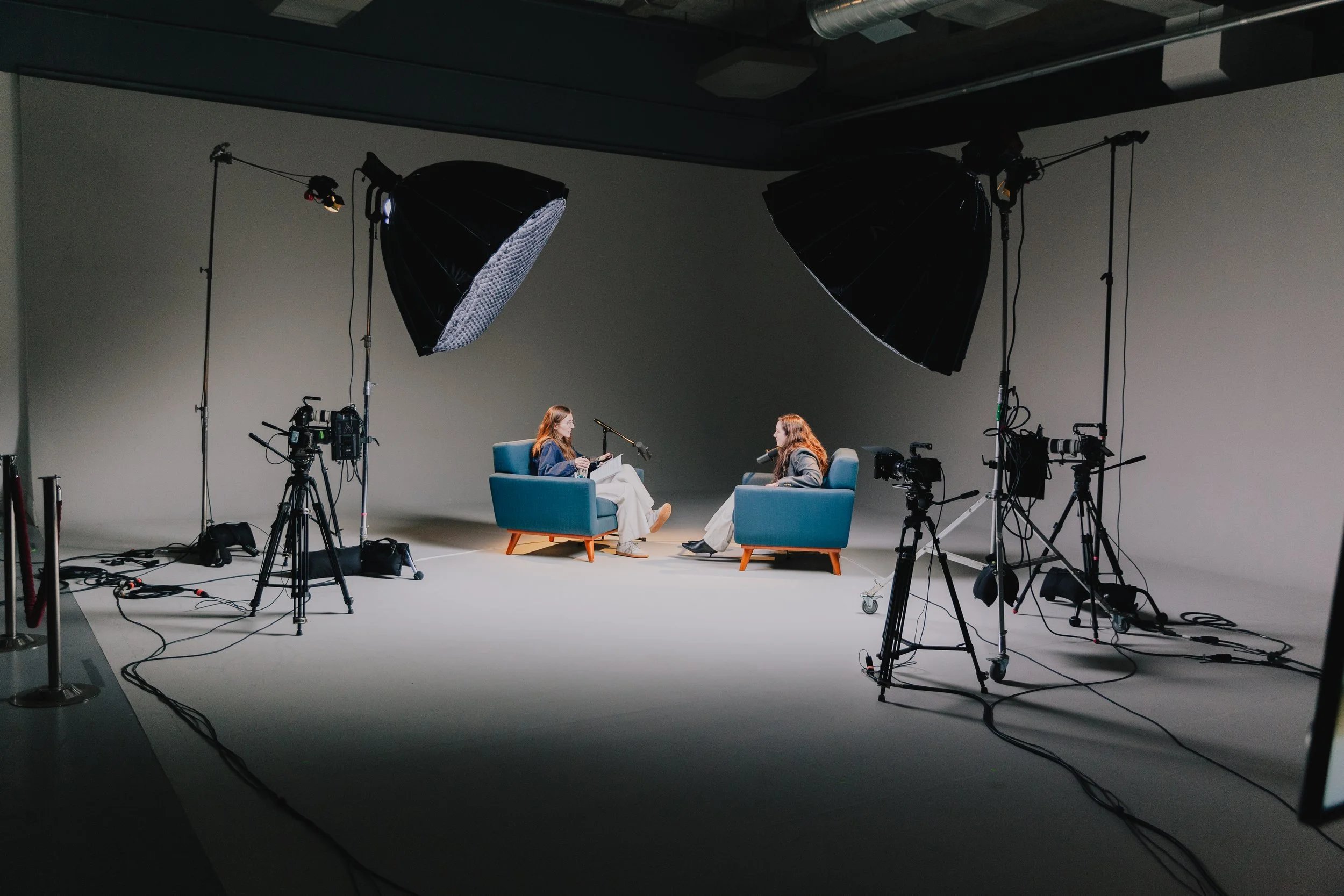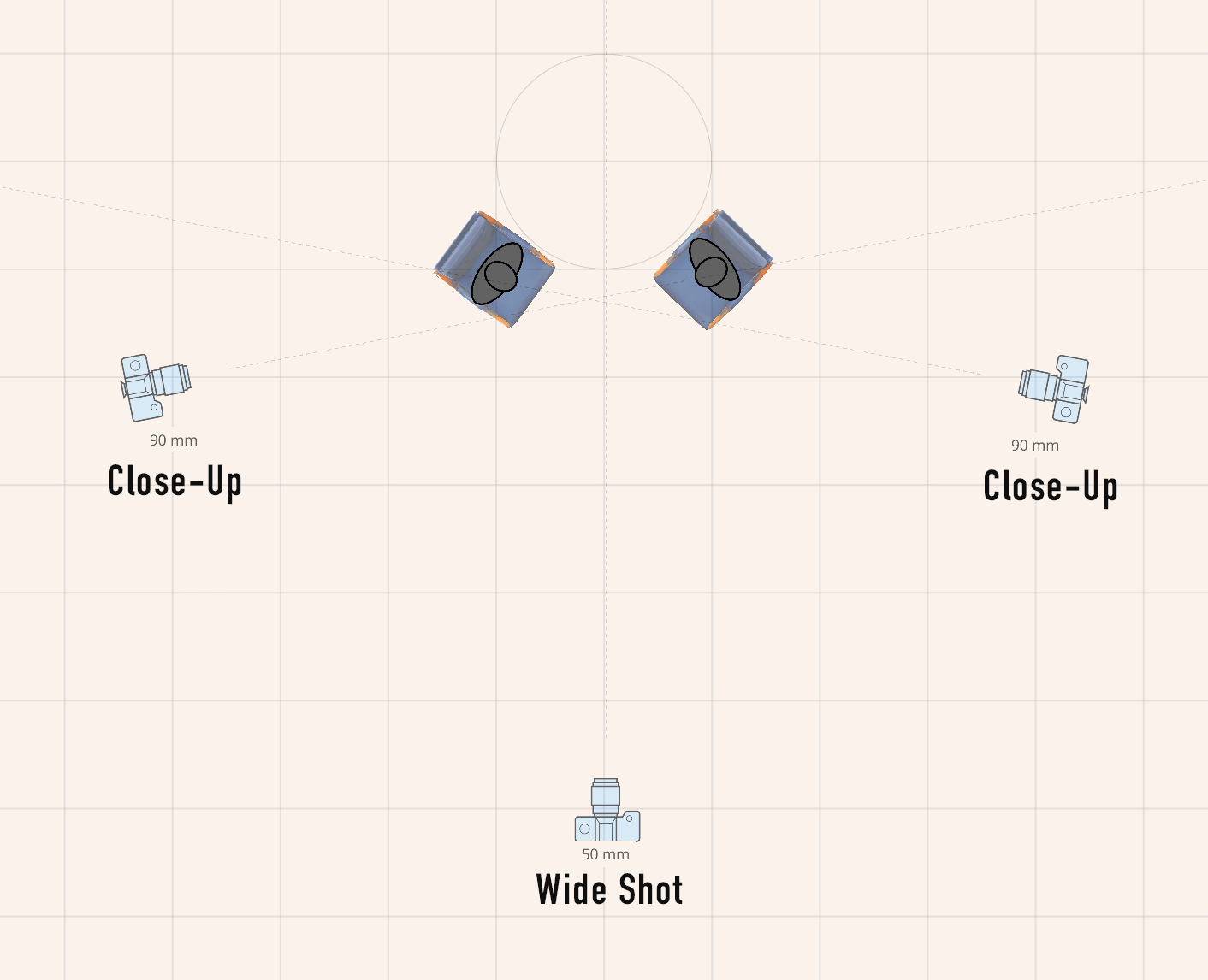How to setup a podcast studio
Building a podcasting recording studio can be fun, rewarding, and useful. There are four major departments to consider when designing your studio— sound, camera, lighting, and set design. Let’s dive in!
Set Design
FROM NOW ON with Lisa Phillips, set design by Podhead Studios
When considering the set design of your podcast studio setup, begin by asking yourself the big questions. What should the visual design, say, feel, or evoke? How do you want your branding to be percieved? What do you want to express?
Answering these broad-stroke questions can guide you on your creative decisions and lead to informed choices and cohesive visuals.
For example, if you’d like your show to feel fun, playful, or joyous, how might you express that with the visual design?
Perhaps you are using fun and bright colors for the background walls. Color can be a great source of symbolism and meaning. Yellow can symbolize happiness, friendship, or energy. Blue can symbolize trust, loyalty, and depth.
Perhaps your chairs are fun, modern, or abstract? Perhaps your guests are sitting on bean bags? Think about how this would make your guests feel for the conversation they are about to have. (For more on chairs, check out our Blog Post! all about them)
Sometimes less is more. Curate your set decoration so that the important elements truly stand out
For your “set dec”, you can also embed visual cues to build authenticity and detail into your design. What kind of imagery fits the culture of your show? Think about what kind of pieces you can use to signal meaning to your viewers.
For the ZEKE AND LUTH Podcast, we collaborated with mural artist, Arturo Orellana, to create original artwork that evoked skater culture of the early 2000s.
For size and the spacial properties of your set, the space you have can sometimes be limiting. However, it’s generally considered advantageous if you can use a bigger space with more depth and distance in the background of your shots. Podcasts where your host or guests are up against a wall can give a claustrophobic feeling, while big open spacious sets convey a greater sense of production value.
Set Design mock-up for ARLAN’S ALL ACCESS starring Arlan Hamilton
A bigger space can also allow your cameras to be further away from your guests, which allows you to use a longer focal length lens. This is usually more flattering for faces, but more on this later.
Lighting
Lighting is truly the essence of great photography. Mastering lighting can be a lifelong endeavor, but a few basic principles can truly guide you on your journey to setup a podcast studio.
As with Set Design, we want to begin with big creative questions — how do we want the audience to feel?
Light can have many qualities and it’s how we use the qualities to give the viewer a feeling. Within the language of lighting, we can explore how darker, moodier, or dramatic lighting styles make us feel. We can also look at how bright, flat, or softer lighting evokes feeling as well.
For setting up a home studio without a professional lighting crew or equipment, try to focus on lighting environments that aren’t distracting. Avoid harsh shadows or harsh light sources.
You can also purchase simple soft box lighting kits on B&H for very reasonable prices. Using soft boxes can allow you to cast a pleasing soft light across faces. For a general rule of thumb, the larger and closer the light source, the softer it will be. Place your lights at a 45 degree angle from the face to create a bit of dimensionality.
If you have resources for more lighting units, see if you can add a back-light or rim-light behind your subjects. This can give the effect to “separate” them from the background, creating an image with more depth and dimension.
Finally, add lighting to your set design using what are referred to as Practical Lights. These are set pieces like lamps, sconces, or any other lighting elements we can see in the shot. This final touch can truly bring your lighting design to life.
Built in sconces for ARLAN’S ALL ACCESS starring Arlan Hamilton
Camera
To capture your video podcast, you’ll need a camera. It’s possible to create a great podcast even with just one! However, for an ideal situation we might recommend you shoot a two-person conversation with at least 3 angles for a multi camera podcast setup.
The camera angles you set up could consist of one Wide Shot and two Close-Ups.
The Wide Shot is important because it sets up the geography and spacial relationships of the people on your podcast. If you just have the two close-ups without a Wide Shot, it can actually be a bit disorienting for your viewers.
The Wide Shot can also be useful in your edits to let the conversation breathe or to punctuate breaks or turning-points. It can also build visual connection when we see two people in the same frame.
Roze Young, host of the DON’T RECYCLE PROJECT
Generally, you might want to design your close-up shots to match. Consider using the same camera, lenses, and placement on your two Close-Ups. Be sure to look closely at the distance to the subject, camera height, and camera angle to make sure these have symmetry. A tape measure can be a great tool measure height, distance, and placement.
Basic camera placement for a podcast.
For even further discussion on camera angles, be sure to check out our blog post on the craft of Eyelines.
Jose Orellana, head of studio operations @ Podhead Studios, frames a close-up
Sound
Sound is arguably the most important element of all simply because it isn’t forgiving. If it isn’t done right, it can truly tune-out a large number of your viewers.
The basic goal with sound to record clear sounding voices without distractions.
Shure Sm7b, the classic mic of podcasting
When considering your podcast room, start by listening and determining if there is background noise. Is the AC too loud? Street noise coming through the windows? Refrigerator that can’t be unplugged?
See what you can control and select your podcast space based on how good it could sound.
Beyond background noise, it’s important to see how sound travels through the space. Ideally, you’d want a place that absorbs sound and not one that bounces it around. Think about a how sound travels in tiled bathroom, with all those hard surfaces creating reverb and echo. This is what you don’t want.
Instead, look for spaces that dampen sound. Carpets, acoustic foam panels, and furniture can absorb sound reflections and truly help to make a room sound great.
For a recoding setup, you’ll need two microphones, stands, cables, and a recording device that can record on multiple tracks. Many retailers even offer packages which include all these items.
Zoom Podtrak p4 Multitrack Recorder
For microphones, you have many choices and with our current level of technology, many of the options are fantastic for low budgets. Look for Cardioid microphones, which are designed to pick up sound from the front and reject sound from the rear. Be sure to have guests speak directly into the mic and place it nearby for the clearest sound.
Conclusion
With a bit of craft-work, research, and thoughtfulness you can truly setup your podcast studio setup for success!
Feel free to contact us if you have any questions or want to ask about our podcast studio in Los Angeles.

